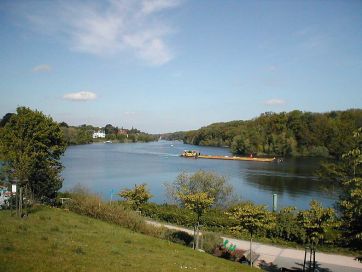The Old Mill in Klein-Glienicke

Many centuries ago, when the areas surrounding the blue river Havel were still inhabited by the Slavic tribe of the Wends, the land (which was beneath the waves of the ocean in ancient times) was covered everywhere with forests and swamps. Every year, when the snow melted, the waters spilled far out of their riverbeds. The higher elevations then rose up like islands above these waters, and as there were only few bridges and dikes, it was time-consuming and difficult to travel from one of the settlements to the next, as these were hidden and protected by the dense and deep swamped forests, and scattered across the region.
Most of the inhabitants of these lands lived off hunting and fishing. Only a few turnips and other native plants were grown on their small fields. In contrast, their herds were large, and found ample food on the wide moors and meadows. While the planting of certain grains had spread here from the lands south of the Elbe river, it was time-consuming and grueling work to pound the oat and barley grains into a rough flour, or to mill them on primitive quern-stones.
During these times, a man lived on the river island of Glienicke who could fashion such devices. He shaped them with a hatchet and a knife, sold them, and in this manner eked out a living for his wife and children. Since he always wanted to make the quern-stones better and more lightweight, he always spent much unnecessary time tinkering with them. And when he had finished a quern-stone that was different from the conventional ones, nobody wanted to buy it. In this manner, he became poorer and poorer. Furthermore, his wife plagued him with reproaches about his clumsiness and laziness, which she blamed for the fact that she and the children had to starve.
The poor man was very distressed and was close to despair. But one midnight, when he was busy carving a wheel, a black man stepped into his hut. But this was an evil spirit. He said that he wanted to make the poor man rich if he gave him a soul to torment. However, the man was horrified and did not want to do so. The next month, the evil spirit returned, and he came back in the third month as well. During this time, the poor man didn’t succeed at anything, and he and his family almost died of starvation. But that night, his wife woke up when he shouted “No! No!” once more. When she heard what the evil spirit wanted, she joined the two and argued with the man that they should hand over a soul so that they wouldn’t all die. But when the man agreed and the evil spirit wanted to have one of the nine children, she cried and wailed so much that the spirit became afraid. And when the Moon rose up, he had to leave. But before he left, he passed his hand over the head of the woman. Then all her beautiful long hair fell out. The evil spirit took the hair with him and said: “Just wait!”
The following night, the evil spirit knocked on the door, quietly invited the man outside, and led him to the mountain near Glienicke, where the large sand pit is located now. There, he threw three raven’s feathers into the air, and soon a large storm arrived. The Griebnitzsee lake churned, its waves broke through between the observers and the Babelsberg hill, and rushed down into the Havel. And when the waters became calm again, a bright stream flew from the Gribitzsee into the river.
Then the spirit led the poor man to the stream and taught him to build a mill whose wheel was powered by the water. This was the first watermill in these lands, near and far, and for three times thirty years no other watermill could be built within a distance of three rooster’s crowings. And the man became very rich and lived for a long time, and the nine children became his assistants. Then the plague reached these lands. All children died, and only he and his wife survived in the mill. But since he was overcome by grief, he soon died as well. The mother then buried him next to the nine sons, at the spot where the large linden tree in front of the forestry office is located now.
The lord of this land put another miller into the mill to work it, and this miller drove the mother away. But she returned to the graves at the lake every night. Where she died and where she was buried, nobody knows. But even now, a gray old woman can allegedly be seen at night under the tall linden trees near the mill.
Source: Reinhard - Sagen und Mährchen aus Potsdams Vorzeit, p. 16ff